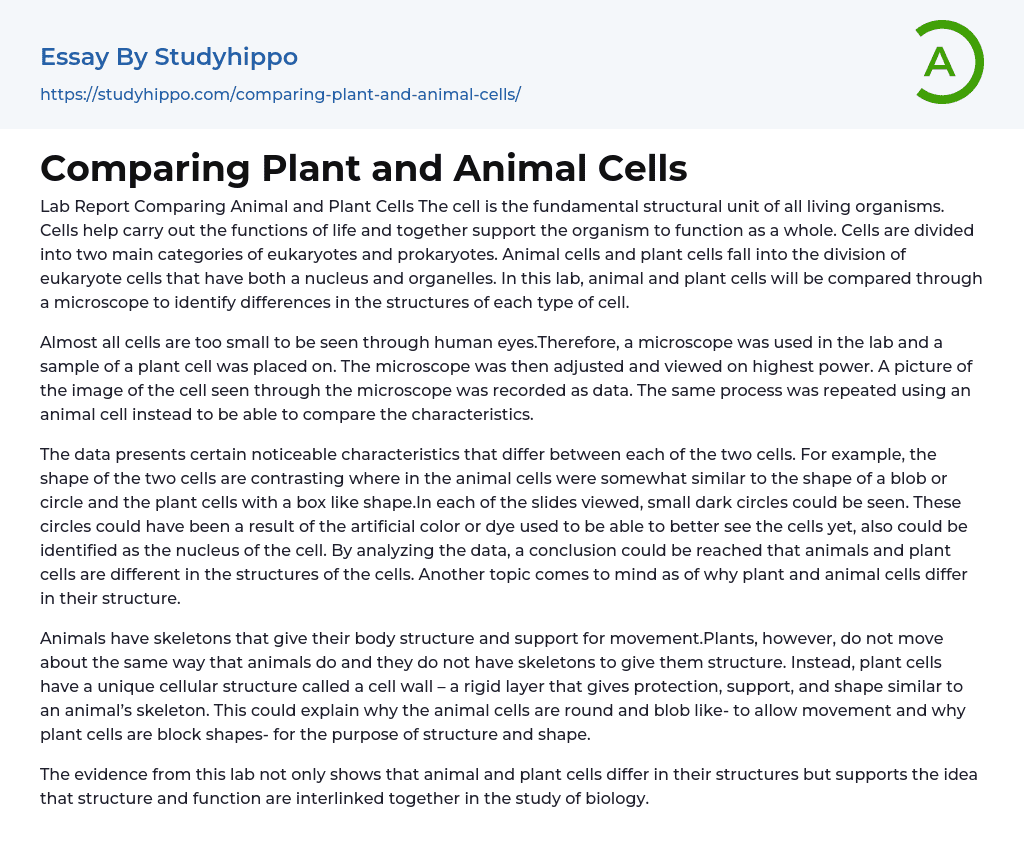Lab Report Comparing Animal and Plant Cells The cell is the fundamental structural unit of all living organisms. Cells help carry out the functions of life and together support the organism to function as a whole. Cells are divided into two main categories of eukaryotes and prokaryotes. Animal cells and plant cells fall into the division of eukaryote cells that have both a nucleus and organelles. In this lab, animal and plant cells will be compared through a microscope to identify differences in the structures of each type of cell.
Almost all cells are too small to be seen through human eyes.Therefore, a microscope was used in the lab and a sample of a plant cell was placed on. The microscope was then adjusted and viewed on highest power. A picture of the image of the
...cell seen through the microscope was recorded as data. The same process was repeated using an animal cell instead to be able to compare the characteristics.
The data presents certain noticeable characteristics that differ between each of the two cells. For example, the shape of the two cells are contrasting where in the animal cells were somewhat similar to the shape of a blob or circle and the plant cells with a box like shape.In each of the slides viewed, small dark circles could be seen. These circles could have been a result of the artificial color or dye used to be able to better see the cells yet, also could be identified as the nucleus of the cell. By analyzing the data, a conclusion could be reached that animals and plant cells are different in the structures of
the cells. Another topic comes to mind as of why plant and animal cells differ in their structure.
Animals have skeletons that give their body structure and support for movement.Plants, however, do not move about the same way that animals do and they do not have skeletons to give them structure. Instead, plant cells have a unique cellular structure called a cell wall – a rigid layer that gives protection, support, and shape similar to an animal’s skeleton. This could explain why the animal cells are round and blob like- to allow movement and why plant cells are block shapes- for the purpose of structure and shape.
The evidence from this lab not only shows that animal and plant cells differ in their structures but supports the idea that structure and function are interlinked together in the study of biology.
- Rabbit essays
- Distribution essays
- Large Animals essays
- Mouse essays
- Poultry essays
- Animal Abuse essays
- Cats Vs Dogs essays
- Cattle essays
- Territory essays
- Oxygen essays
- Atmosphere essays
- Coral Reef essays
- Desert essays
- Earth essays
- Ocean essays
- Lake essays
- Sea essays
- Biodiversity essays
- Natural Environment essays
- Forest essays
- Soil essays
- Water essays
- Rainbow essays
- Ecosystem essays
- Volcano essays
- Wind essays
- Forestry essays
- Bottled Water essays
- Tree essays
- Seed essays
- Agriculture essays
- Albert einstein essays
- Animals essays
- Archaeology essays
- Bear essays
- Biology essays
- Birds essays
- Butterfly essays
- Cat essays
- Charles Darwin essays
- Chemistry essays
- Dinosaur essays
- Discovery essays
- Dolphin essays
- Elephant essays
- Eli Whitney essays
- Environmental Science essays
- Evolution essays
- Fish essays
- Genetics essays




